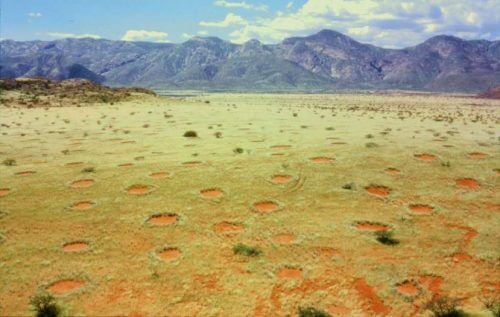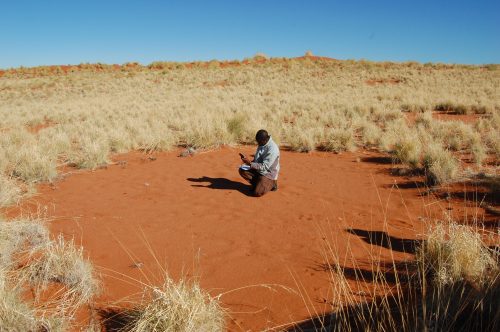A new study in which an Israeli researcher is involved shows how the mysterious vegetation circles are formed in the African deserts

By Yoni Weitz, Angle, Science and Environment News Agency
The grasslands of Namibia, southwest Africa, are dotted from edge to edge with round, plantless patches surrounded by thick rings of grass. These large circles, which are arranged perfectly and are called "fairy circles", have fascinated researchers and nature lovers for years.
The members of the local "Himba" tribe refer to the circles exposed by vegetation as the "footprints of the gods". Members of other Bushmen tribes see them as tombstones created for the tribesmen who died in the campaign against the conquerors, white or black. Scientific theories try to provide an explanation for how the circles were created - for example, that the reason for this is thatplants Competing for resources in the center of the circle, and that the circles were created because animal activity. And yet - there is no plausible explanation.
Colonies in the desert
These days, A new study published in the prestigious journal Nature By a group of researchers from various universities in the world, including a researcher from Israel, the combined mechanism of the flora and fauna that causes this phenomenon - which is primarily related to the activity of termites, social insects living in colonies - is revealed.
Dr. Efrat Shafer, a researcher from the Faculty of Agriculture, Food and Environment at the Hebrew University of Jerusalem, who is a partner in the research, explains: "Initially, through field mapping and through aerial photographs, we mapped and measured where the circles and termite nests are located in the space. We have seen that in many places in the world the same phenomenon takes place: in all cases each colony occupies a fixed distance from all the neighboring colonies, and almost always each colony has the same number of neighboring colonies - six. This is an ideal arrangement, reminiscent in shape of a beehive." The team of researchers showed that this organization of the termite colonies in a perfect spatial arrangement appears not only in Namibia, but in different places in the world such as Kenya, Brazil, Australia and the United States.
Until recent years, a theory was established, developed by Prof. Ehud Maron from Ben Gurion University, which explains the organization of desert plants in circles as a result of competition for water between plants. Studies are instructive that desert plants are spatially organized in dry conditions in the form of small rings. But contrary to the intuitive concept that nearby plants will compete for resources in their immediate environment, and therefore prefer to stay away from each other, today it is known that the roots in the soil help improve soil conditions and prevent loss of water and minerals. So in fact, plants in arid habitats will prefer to grow next to each other and will form dense circular structures.

However, it now turns out that the "fairy circles" phenomenon is more complex. Shafer explains: "The new research offers a theory that combines the plants and the termites. This theory explains the large icy circles, which are created as a result of the presence of termites that eat the plants inside the circle, and also the smaller patches of vegetation in the areas between the circles - which result from competition between plants for water." Each circle actually "belongs" to a termite colony that shapes the landscape in its territory. The colonies compete for the amount of food - the plant material - which is taken away from the center of the circle, thus creating clear boundaries between the colonies and the ordered spatial model.
Termites against climate change
An important and interesting side of the research reveals the possible connection between the "fairy circles" in Africa and the desert phenomenon. in their previous study, held in the savannah of the Mpala Game Reserve in Kenya, the research team showed that the termites enrich the soil and are responsible for improving the beneficial conditions for the plant. The researchers noticed that in the dry season, the vegetation around the nests is yellow and dry, but even then - the nest areas remain green, like "islands", and maintain a high biological diversity - this is due to moisture that accumulates in the ground in the termite nests. Now, according to a model developed by the researchers, in a scenario of climate change and desertification, even with a 30 percent decrease in annual precipitation, the vegetation around the nests will maintain resistance, and biodiversity will remain high.
And in Israel? Vegetation circles reminiscent of the Namibian fairy circles have not yet been observed in Israel, and termites in Israel are known mainly as a pest species and not as environmental engineers. However, according to Shaffer, it is not impossible that here too we will be able to identify interesting phenomena in desert areas where there are social insects organized in colonies, such as ant nests. These insect colonies may also turn out to be environmental engineers and turn out to be an important element in the design of the natural landscape in Israel.

2 תגובות
The reason for the fairy circles: thermals that prepare themselves for exposure to full sunlight. And why in a round shape? Because each circle belongs to one termite family that maintains its territory. A round shape is the most useful shape to maintain a territory. Signed by his father. Nobel Prize on the way.
It is appropriate to bring references that were published on the site in the past:
https://www.hayadan.org.il/fairy-circles-explained-1209130
https://www.hayadan.org.il/fairy_circles_assaf/